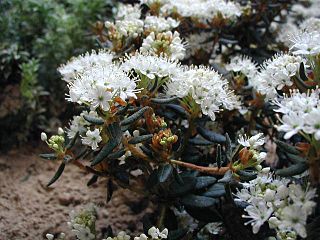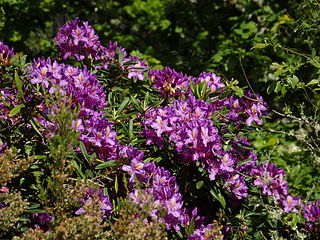
Rhododendron is a very large genus of about 1,024 species of woody plants in the heath family (Ericaceae). They can be either evergreen or deciduous. Most species are native to eastern Asia and the Himalayan region, but smaller numbers occur elsewhere in Asia, and in North America, Europe and Australia.
Grayanotoxins are a group of closely related neurotoxins named after Leucothoe grayana, a plant native to Japan originally named for 19th century American botanist Asa Gray. Grayanotoxin I is also known as andromedotoxin, acetylandromedol, rhodotoxin and asebotoxin. Grayanotoxins are produced by Rhododendron species and other plants in the family Ericaceae. Honey made from the nectar and so containing pollen of these plants also contains grayanotoxins and is commonly referred to as mad honey.

Satsuki azalea is a cultivar group of the species Rhododendron indicum, a type of azalea extensively cultivated and hybridized by the Japanese. It is native to the mountains of Japan.

Rhododendron tomentosum, commonly known as marsh Labrador tea, northern Labrador tea or wild rosemary, is a flowering plant in the subsection Ledum of the large genus Rhododendron in the family Ericaceae.

Gracillariidae is an important family of insects in the order Lepidoptera and the principal family of leaf miners that includes several economic, horticultural or recently invasive pest species such as the horse-chestnut leaf miner, Cameraria ohridella.

Rhododendron ponticum, called common rhododendron or pontic rhododendron, is a species of Rhododendron native to the Iberian Peninsula in southwest Europe and the Caucasus region in northern West Asia.

Rhododendron schlippenbachii, the royal azalea, is a species of Rhododendron native to the Korean Peninsula and adjacent regions of Northeast China, Japan, and the Russian Far East. It is the dominant understory shrub in many Korean hillside forests, growing at 400–1,500 m (1,300–4,900 ft) altitude.

Caloptilia azaleella is a moth of the family Gracillariidae. It is endemic to Japan, but has been introduced worldwide, wherever there are Azaleas.
Dialectica geometra is a moth of the family Gracillariidae. It is known from Hong Kong, Japan, India and Réunion. It has recently been recorded from China.
Phyllonorycter yakusimensis is a moth of the family Gracillariidae. It is known from the island of Kyūshū in Japan.

Caloptilia zachrysa is a moth of the family Gracillariidae. It is known from China, India, Japan, Korea, Sri Lanka and Taiwan.
Caloptilia leucothoes is a moth of the family Gracillariidae. It is known from the islands of Hokkaidō, Honshū and Kyūshū in Japan, from the Russian Far East and from Korea.

Phyllonorycter ledella is a moth of the family Gracillariidae. It is known from Québec, Canada, and California, United States. The species is listed as endangered in Connecticut.
Phyllonorycter rhododendrella is a moth of the family Gracillariidae. It is known from Tennessee, United States.
Caloptilia ferruginella is a moth of the family Gracillariidae. It is known from the United States (California).
Caloptilia rhodorella is a moth of the family Gracillariidae. It is known from Nova Scotia, Canada.
Caloptilia porphyretica is a moth of the family Gracillariidae. It is known from North Carolina and New Jersey in the United States.

Rhododendron indicum is an azalea Rhododendron species native to Japan.

Gracillariinae are a subfamily of moths which was described by Henry Tibbats Stainton in 1854.

The Haaga Rhododendron Park is a public park containing various varieties of rhododendron, located in the district of Haaga in Helsinki, Finland. Although originally used for breeding and research purposes, the park is now a popular attraction among locals.









